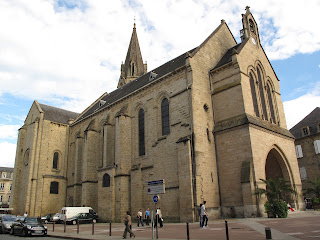 |
| le blazon du Brive-la-Gaillarde |
.jpeg) |
| Tour de Cesar/ Allassac |
 |
| l'eglise d'Objat |
 |
| Brive-la-Gaillarde / la bassin du Brive |
The town was always Brive, but it gained it's sobriquet, la Gaillarde...which translates to "the gallant" after WW2. Brive was an important center for the French Resistance and was the first French city to officially liberate itself from the Nazis. Indeed all over the medieval center, there are many monuments remembering individual heros and squares renamed in their honor.
It's a rough hewn city. The massive architecture of the Correze constructed with carefully cut stone blocks of brownish grey limestone or carefully cut asymmetrically fitted pieces of granite define the look. It is an massive architecture defined by eccentric detail. As you walk through the circular maze of the old medieval city, you are constantly coming on unexpected cul-de-sacs hiding renaissance towers, elegantly hewn masonry...architecture that reveals the unplanned civic evolution of almost 1000 years. But Brive is not a historical monument frozen in time. This is a culturally vibrant living city. The home of France's biggest festival of literature, out side of Paris, Le Foire de Livre in November is host to hundreds of authors with a special train that comes from Paris to transport the writers. Brive is the best sports town in Central France...CA Brive Rugby is the premier regional team.As a passionate bicyclist, I am always amazed at how many cycling stores are in the region and how many serious teams they support. Then, of course, the food. Sigh....Perhaps worthy of a totally different post. This is seriously gourmand town. What do you like? Patisserie? Chocolate? The best cul noir, maigret ou boeuf de limousin? Charcuterie? The area is well known for the distillation of specific alcoholic products, like Gentiane and you can visit the Denoix Distillerie where their famous walnut aperative, among other varieties are made....All in all a great place to just hang out. So many little cafes, the perfect place to perfect the lost art of wasting time with a great cafe corse in a sunny medieval square in a cul-de-sac off a seemingly forgotten medieval back street. Which is what I did, on a perfectly sunny freakishly pre spring day in a t shirt, warm in the sun.
So, yesterday I gave myself the entire day to hang out. As we crossed the medieval center of the town, we saw that the entire circular heart around the 12th Century church, La Collegiale Saint-Martin was enclosed by fences and being excavated. The Saint Martin is Saint Martin of Spain, who is buried there.
The church was originally from the Dark Ages, with Merovingienne crypts under the more modern structure dating from the 12th century. The pavement of the central oval the church is located on was interrupted by a huge fenced off pits that were being worked on by teams of archaeologists. The were uncovering, 6 feet below the present street, ground level of Brive prior to 1000 ad. Even more amazing, they had discovered graves dating back to the pre 500 ad and were carefully examining skeletons in the earth. I spoke with one of the researchers and she let me into the site. I think she was amazed that I was able to convey with my very clumsy French my passion for and understanding of what I was looking at. When we got home later that evening, I turned on France3 Limousin and saw a little report on what I had just seen in person....here it is:


2 comments:
Interesting post. You can't beat France for beauty in all sorts of places. http://caroleschatter.blogspot.co.nz/2011/11/saint-ceneri-le-gerai.html
interesting post -- why are they excavating these graves? keep us updated!
Post a Comment